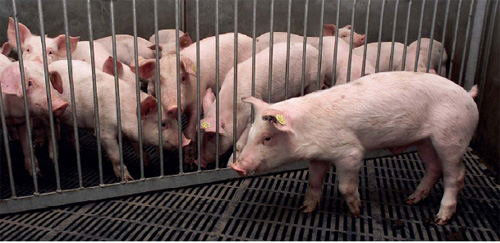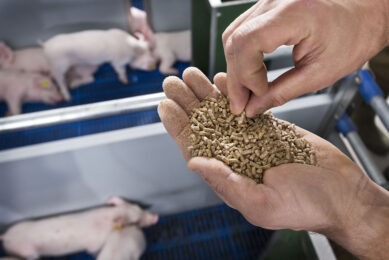Limiting antibiotic use with total gut health concept

Feed products designed for intestinal health have emerged to contribute to health management practices, generally focusing on promoting the growth of beneficial microbiota, and reducing pathogens. However, recent insights demonstrate that the efficacy of a gut health concept can be markedly improved by optimising both microbiota and gut barrier function. This integrated approach includes stabilisation of the microbiota and enforcing the mucosal barrier properties.
Since the ban on antimicrobial growth promoters in the European Union, pig farming is dealing with a greater challenge to maintain a high health status. Antimicrobial growth promoters contributed to prevention of gastrointestinal bacterial infections caused by various stress factors. In intensive farming systems, these stress factors include disease pressure, transportation, vaccination, feed transitions and environmental factors. In recent scientific literature, it has become more evident that stress plays a major role in disturbing the gut environment. There are essentially two ways, by which stress contributes to gut health problems:
a) by causing disturbances in gastrointestinal motility and feed intake patterns leading to microbial imbalance and increased risk of infections;
b) by causing systemic changes in the animal such as oxidative stress and inflammation leading to loss of gut barrier integrity. Microbial dysbiosis along with gut barrier dysfunction causes poor digestion and inflammation. These, in turn, can lead to poor feed efficiency and daily gain as well as diarrhoea and infections. For the farmer, this means more use of drugs, increased veterinary costs, high mortality rates and – ultimately – financial loss.
The ban on antimicrobial growth promoters led in some countries initially to a serious increase in use of therapeutic antibiotics in European countries. Nowadays there is public and industry concern about the prudence and sustainability of antibiotic use and its potential long-term impact on public health. For a responsible use of antibiotics, the need for a highly effective prophylactic approach to animal health is clear. Recent advances indicate that a combined dietary strategy of microbiota stabilisation and gut barrier enforcement is highly promising.
Microbiota management
New scientific opinions on gut microbiota management demand a more in depth look in population changes than just measuring single species to understand and solve the problems of the gut microbial ecosystem. To modulate the microbiota dynamics in the gut, Nutreco R&D developed a database with information about the microbial growth modulating properties of a wide range of natural compounds using robotised high-throughput methods. Target microbial species were e.g. Lactobacillus species and pathogenic strains of Clostridium species, Streptococcus suis species, E.coli species and Salmonella species. From the database compounds were selected for further in vivo studies in the complex microbial ecosystem of the gut in piglets. Based on the results of compound screening studies, various test blends were formulated for pigs and poultry for further research. Final blends were integrated in a new gut health product called Presan.
Furthermore, quantitative real time PCR and one of the latest technologies in the ‘-omics’ area called ‘bar-coded pyrosequencing’ were applied. The latter technology also requires advanced bioinformatics tools to analyse and interpret the data. The pyrosequencing technique enables the user to make a complete overview of the intestinal microbiota population in one analytical run and can be used to study changes in microbiota associated with poor animal health.
Total bacterial count
Studies done using these techniques revealed that, occurrence of non-infectious diarrhoea in piglets may be associated with a rise in total bacterial count in the small intestinal tract. Moreover, tendencies were found that after stress periods such as weaning, the diversity of microbial population was decreased, which is indicative for a situation of overgrowth of the specific microbial species. This over-dominance of a few species leads to imbalance in the microbial population. Scientific literature also indicates that microbial overgrowth in the small intestine may lead to maldigestion and malabsorption. Furthermore, exposure of the more sensitive upper small intestinal tract to high numbers of microbes can cause inflammation, which will lower feed intake and reduce daily gain.
The dietary inclusion of the blend of selected natural ingredients reduced the microbial numbers in the small intestine effectively. Lower numbers of total bacterial count were determined in the upper and lower small intestine (see Figure 1). Furthermore, pyrosequencing data clearly showed that the addition of the same blend in the diet, increased small intestinal microbial diversity one week post-weaning (see Figures 2a and 2b). The number of observed species was decreased in piglets at day seven post-weaning, whereas in piglets fed the experimental feed with the natural ingredients blend, diversity was similar to the piglets preweaning. This was also visible in the community profiles.
Gut barrier management
Focusing on microbiota management alone limits the success of a gut health concept, as the important part of the gut barrier defence is ignored. Gut barrier dysfunction may lead to a higher exposure to antigens, toxins and pathogens and is therefore critical for maintaining good health. Key components of the gut barrier are nowadays well described in literature and include the mucus layer, the permeability of the epithelial cell layer covering the intestinal mucosa and the response of the gut associated immune system. The very first thing that needed to be solved was to find a reliable and reproducible in vivomodel to study barrier function in nutritional intervention studies. This led to the development of a novel gut barrier stress model in collaboration with leading universities in this field of research.
The model induces a gut barrier dysfunction and various parameters that are critical in relation to gut barrier function can be studied.
| The main differences between a healthy and a damaged intestinal wall are: A damaged gut wall contains more bacteria; is in dysbiosis due to pathogen pressure; has more lesions; poorer tight junctions, resulting in translocation of bacteria; and has shorter villi. |
Attention for example is paid to gut barrier characteristics, such as gut permeability, in relation to inflammation parameters. Inflammation may be the result of a ‘leaky’ gut, but also vice versa inflammation may be the causative factor for a leaky gut by damaging the mucosa. Specific natural ingredients in the blend have shown in research to exert anti-inflammatory effects along with antimicrobial potency.
In the ‘in vivo gut barrier stress model’, when tested against the control diet group, the blend significantly reduced expression of inflammatory cytokines (see Figure 3). Control of inflammation is an important prerequisite for control of gut barrier function.
Combined approach
Promising results have been obtained testing the combination of these microbiota and gut barrier management strategies on performance and health of weaned piglets.
In various experimental studies done under challenge and non-challenge conditions, the new concept showed significant improvements in daily gain, feed efficiency and reduced diarrhoea in weaned piglets. At this stage extensive validation studies and field trials are on-going to confirm and further support these findings. The results to date suggest that the microbiota and barrier management concept not only offers to be a viable alternative to antimicrobial growth promoters, but may also help reduce the use of therapeutic antibiotics effectively. This would have important positive implications for animals, farmers and society.
Authors would like to acknowledge the scientific partners from NIZO Food Research, Utrecht University, Wageningen University and INRA for their scientific support.
- NOTE: TO SEE THE FIGURES MORE CLEARLY, CLICK HERE FOR A PDF VERSION
Join 18,000+ subscribers
Subscribe to our newsletter to stay updated about all the need-to-know content in the pigsector, three times a week. Beheer
Beheer










 WP Admin
WP Admin  Bewerk bericht
Bewerk bericht